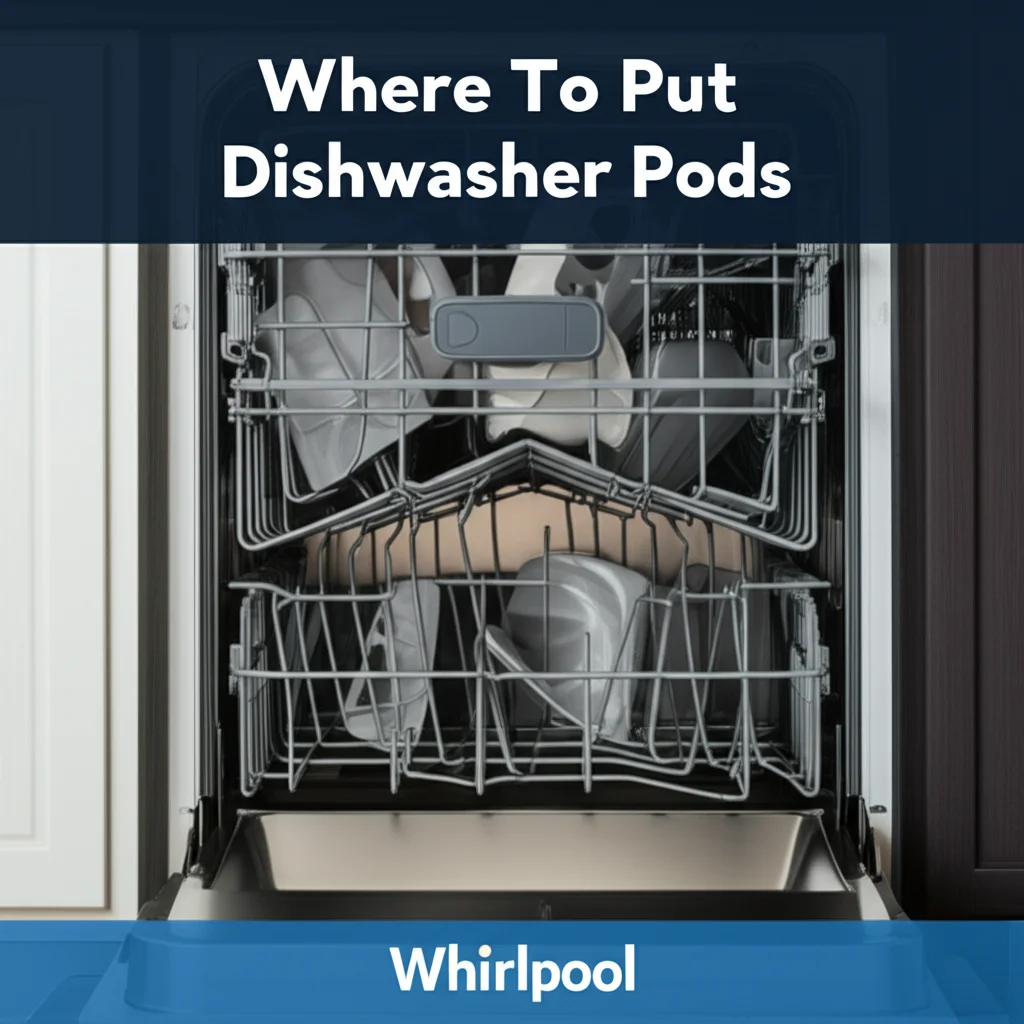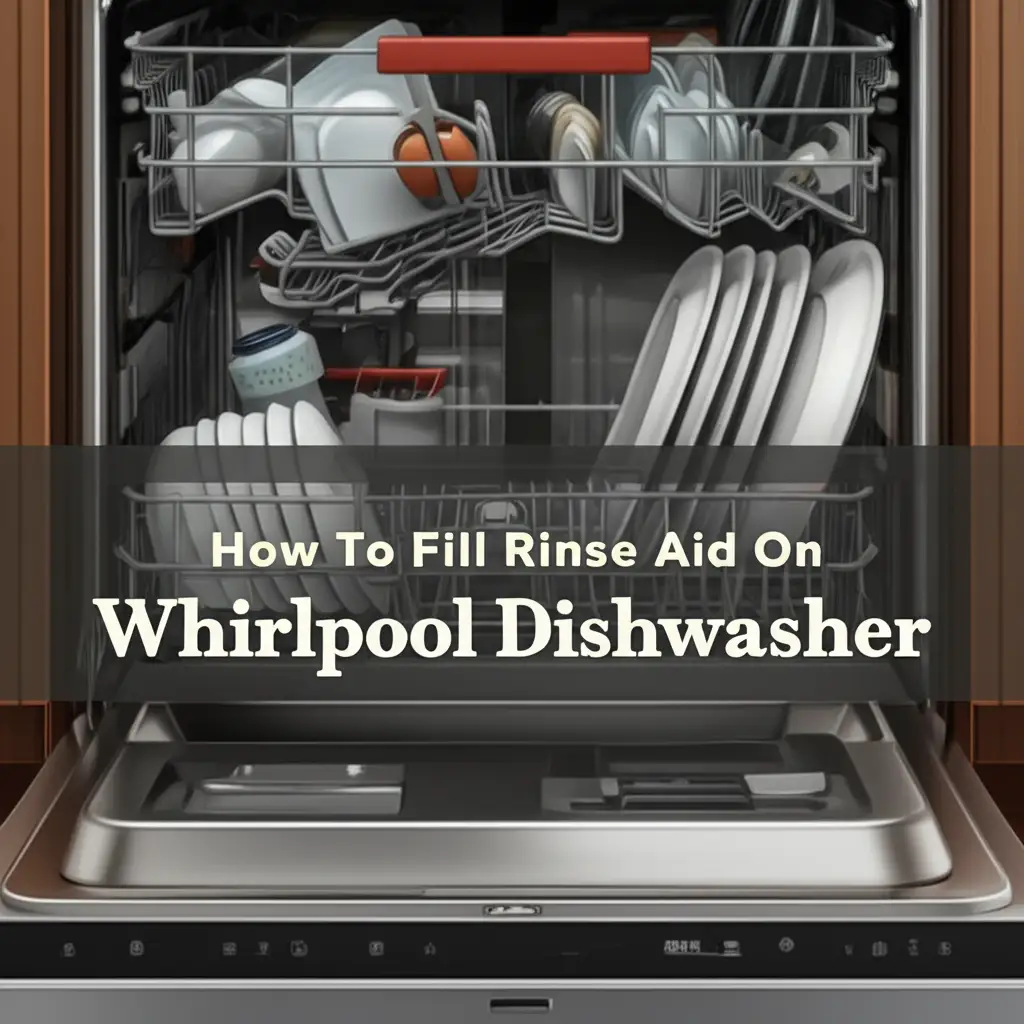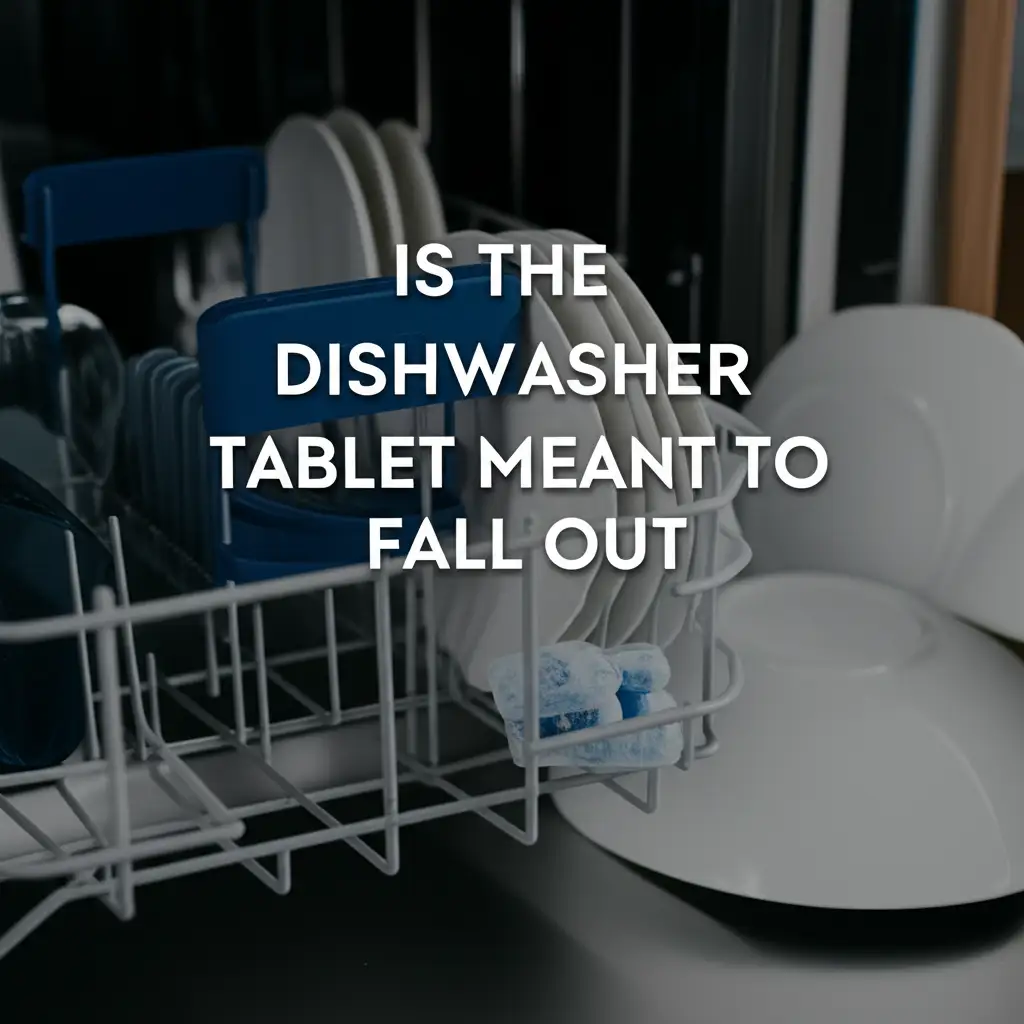· Todd Martin · Dishwasher Maintenance · 20 min read
Where To Put Dishwasher Pods Whirlpool

Where To Put Dishwasher Pods in Your Whirlpool Appliance
Getting your dishes perfectly clean often comes down to a small but important detail: knowing where to put dishwasher pods in your Whirlpool machine. Many of us simply toss a pod inside, hoping for the best. However, correct placement is key to ensuring your dishes get the thorough wash they deserve. A misplaced pod can lead to undissolved detergent, spotty dishes, or even a rewash. This guide will clarify the exact spot for your dishwasher pod, especially for Whirlpool models.
I remember my early days with a new Whirlpool dishwasher. I was unsure about the right spot for the detergent. Would it go in the bottom? Tucked away in a secret compartment? Learning the correct method transformed my dishwashing results. We will cover the specific location for your dishwasher pods and offer valuable tips for maximizing your Whirlpool dishwasher’s performance. You will learn about the detergent dispenser, how pods work, and common issues to avoid.
Takeaway
- Always place dishwasher pods in the main wash detergent dispenser cup.
- Do not place pods in the pre-wash compartment or directly in the tub.
- Ensure the dispenser door is not blocked by dishes.
- Regularly clean your dishwasher filter and interior for best results.
- Use rinse aid for enhanced drying and shine.
For optimal cleaning, place your dishwasher pod in the main wash detergent dispenser compartment. This small door is usually on the inside of the dishwasher door. The pod will release at the correct time during the wash cycle. This ensures proper dissolution and effective cleaning action for your dishes.
Understanding Your Whirlpool Dishwasher’s Detergent Dispenser
When you open your Whirlpool dishwasher door, you will see a small compartment designed for detergent. This is the detergent dispenser. It is a crucial part of your dishwasher’s operation. This dispenser is engineered to release detergent at the precise moment during the wash cycle. This timing is essential for effective cleaning. Using it correctly ensures your dishwasher pods dissolve completely and work their magic.
Most Whirlpool dishwashers feature a standard dispenser design. It typically includes a main wash compartment and sometimes a smaller pre-wash compartment. These compartments are specifically designed for different stages of the wash cycle. Knowing which one to use for your dishwasher pods makes all the difference. Misplacing the pod can lead to poor cleaning results. Let’s look closer at these parts.
The Main Wash Detergent Compartment
The main wash detergent compartment is the larger section of your dishwasher’s dispenser. This is the primary location for your dishwasher pod. It has a hinged door that opens automatically during the main wash cycle. This timing allows the pod to dissolve when the water is hot and the wash action is most intense.
Placing the pod here ensures it is not released too early or too late. If the pod releases too early, it might be washed away before the main cleaning begins. If it releases too late, the dishes may not get enough detergent for a thorough wash. The main compartment is designed for the detergent to activate at the peak of the cleaning process. This ensures every dish gets sparkling clean.
The Pre-Wash Detergent Compartment
Some Whirlpool dishwashers also have a smaller compartment next to the main one. This is the pre-wash detergent compartment. It is designed to hold a small amount of powder or gel detergent for a pre-wash cycle. This pre-wash cycle helps loosen tough food particles before the main wash begins. However, dishwasher pods are generally not suitable for this compartment.
Dishwasher pods are usually designed to be “all-in-one” solutions. They contain enough cleaning power for the entire wash. Putting a pod in the pre-wash compartment means it will dissolve too early. This wastes the pod’s cleaning agents. The main wash cycle will then lack sufficient detergent. For most modern pods, stick to the main wash compartment only.
The Gold Standard: Placing Dishwasher Pods in the Main Wash Cup
For almost all Whirlpool dishwasher models, the main wash detergent cup is the correct place for your dishwasher pod. This is not just a suggestion; it is how the appliance is designed to function with these concentrated detergents. When you close the dishwasher door, the dispenser door latches shut. It then opens at a specific time during the cycle, releasing the pod into the wash water.
This timed release is critical for the pod to work effectively. Dishwasher pods are carefully formulated to activate in hot water and at a precise moment in the wash. Placing the pod anywhere else can disrupt this process. You might see undissolved pod residue or dirty dishes if the pod is not in the main wash cup. Trust the design of your Whirlpool appliance.
Why the Main Compartment is Best
The main detergent compartment ensures the pod enters the wash at the optimal time. During the main wash cycle, your Whirlpool dishwasher uses hotter water and more vigorous spray action. This environment is perfect for dissolving the concentrated ingredients in a dishwasher pod. If the pod is released too early, its cleaning power is diluted or spent before it can tackle the dirtiest parts of the wash.
If the pod is simply tossed into the bottom of the tub, it can dissolve too quickly during the pre-rinse phase. This leaves little to no detergent for the actual main wash. Dishes can also block the pod from dissolving properly if it is loose in the tub. The dispenser protects the pod until it is needed most. This precise timing leads to cleaner dishes with less effort.
How Pods Dissolve and Release
Dishwasher pods are engineered to dissolve slowly and release their cleaning agents over time. This timed release mechanism is why placement is so important. The outer film of the pod is water-soluble. It begins to dissolve as soon as water hits it. When housed in the main wash dispenser, the pod is protected from early water exposure during the initial rinse cycles.
Once the main wash cycle begins, the dispenser door springs open. The pod falls into the wash chamber. Hot water from the spray arms then quickly dissolves the pod, releasing detergents, enzymes, and rinse aid into the wash water. This ensures a concentrated burst of cleaning power when your dishes need it most. It is a smart system designed for efficiency. For tips on using other brands of pods, you can learn where to put Finish dishwasher pods.
Advanced Insights: When and Why to Use the Pre-Wash Compartment (or Not)
Understanding the roles of the main wash and pre-wash compartments is crucial for optimal dishwasher performance. While the main compartment is universally the spot for pods, the pre-wash compartment has a different purpose. It is generally not suitable for dishwasher pods. This distinction helps you get the most from your cleaning agents and avoid common problems.
Some people might think using both compartments provides extra cleaning power. However, with pods, this is usually counterproductive. Modern dishwasher pods are designed as complete solutions. They often contain enzymes and cleaning agents that work best when released at the main wash stage. Misusing the pre-wash slot can lead to less effective cleaning.
Powder vs. Pods: Dispensing Differences
Traditional powdered or gel detergents often recommend using both the pre-wash and main wash compartments. For very dirty loads, you would put a small amount of powder or gel in the pre-wash slot. This helps tackle stubborn food residues early on. The main wash compartment then holds the bulk of the detergent for the primary cleaning cycle. This two-stage approach works well with those forms of detergent.
Dishwasher pods, however, are different. They are unit dose products. They typically combine several cleaning agents, including a pre-soak, main detergent, and rinse aid, into one compact package. Their formulation means they are designed to be released as a single, powerful burst during the main wash. You generally do not need to supplement them with extra detergent in the pre-wash slot.
Avoiding Pod Misplacement
Placing a dishwasher pod in the pre-wash compartment is a common mistake. If a pod is placed there, it will dissolve during the initial rinse or pre-wash phase. This means its powerful cleaning ingredients are used up on water and lightly soiled items, not the heavily soiled dishes in the main wash. By the time the main wash starts, there is no detergent left. Your dishes will not get properly cleaned.
Another common error is simply tossing the pod into the bottom of the dishwasher tub. This can also lead to incomplete dissolution. The pod might get stuck under dishes or dissolve too quickly before the water heats up. This results in poor cleaning and wasted detergent. Always ensure the dispenser door is clear of obstructions. The correct placement is critical for the pod’s chemistry to work as intended.
Optimizing Cleaning Performance with Whirlpool Pods
Just putting the pod in the right place is a great start, but there’s more you can do. To get the absolute best performance from your Whirlpool dishwasher and your pods, a few other factors come into play. These tips ensure the pod’s ingredients activate correctly and distribute evenly. This leads to spot-free, sparkling dishes every single time.
Achieving superior cleaning goes beyond just detergent placement. Water temperature, how you load your dishes, and the use of rinse aid all contribute to the final result. By addressing these elements, you can prevent common issues like cloudy glasses or food residue. Let’s explore how to fine-tune your dishwashing process.
Water Temperature and Pod Activation
Hot water is essential for dishwasher pods to dissolve and activate properly. Most Whirlpool dishwashers have an internal heater. This ensures the water reaches the optimal temperature for cleaning. If your water heater at home is set too low, or if the dishwasher does not receive hot water at the beginning of the cycle, pods might not dissolve completely.
Before starting the dishwasher, run the hot water at your kitchen sink for a minute or two. This brings hot water to the dishwasher’s inlet valve. This simple step ensures the dishwasher starts with hot water, helping the pod dissolve quickly and release its cleaning agents effectively. Cold water can leave behind undissolved detergent residue or lead to poor cleaning.
Proper Dish Loading for Best Results
How you load your Whirlpool dishwasher significantly affects cleaning performance. Overloading the dishwasher can block water spray from reaching all dishes. It can also prevent the detergent dispenser door from opening fully. This would trap the pod inside. Make sure dishes are not obstructing the dispenser.
Load dishes with the dirtiest surfaces facing the spray arms. Avoid nesting dishes together, as this can prevent water and detergent from reaching all surfaces. Ensure taller items do not block the upper spray arm from spinning freely. Proper loading allows water and dissolved detergent to circulate throughout the entire tub, reaching every item. This ensures the pod’s cleaning power is distributed evenly.
The Importance of Rinse Aid
Rinse aid is a liquid product that helps water run off dishes smoothly. This prevents water spots and streaks, especially on glasses and plastics. Many modern dishwasher pods include a rinse aid component. However, using a separate liquid rinse aid in your Whirlpool dishwasher’s rinse aid dispenser can still enhance drying and shine.
Whirlpool dishwashers typically have a separate rinse aid dispenser next to the main detergent compartment. Fill this dispenser regularly. The dishwasher releases rinse aid automatically during the rinse cycle. This improves drying performance and leaves dishes sparkling. Even if your pod has rinse aid, supplementing it can be beneficial, especially in areas with hard water.
Troubleshooting Common Dishwasher Pod Issues in Whirlpool Models
Even with correct placement, you might sometimes encounter issues with dishwasher pods. Understanding these common problems and their solutions can save you frustration and ensure consistently clean dishes. Most problems relate to pod dissolution or residue. Often, the fix is simpler than you think.
Many factors can influence how well a dishwasher pod performs. Hard water, improper loading, or even a dirty dishwasher can hinder the pod’s effectiveness. Identifying the root cause helps you address the problem directly. Let’s look at some of the most frequent complaints regarding pods in Whirlpool dishwashers.
Undissolved Pods and Residue
If you find an undissolved or partially dissolved pod after a wash cycle, several reasons could be at play. The most common cause is the dispenser door being blocked. Make sure no large dish or utensil is in front of the dispenser, preventing it from opening fully. This traps the pod inside.
Another reason could be insufficient hot water. As mentioned earlier, ensure hot water is readily available at the start of the cycle. Low water pressure can also be a culprit, as it might not provide enough force to fully dissolve the pod. Lastly, check if your dishwasher’s spray arms are clogged or not spinning freely. Blocked spray arms prevent water from reaching the pod effectively. If you’re concerned about buildup, understand that can dishwasher pods cause clogs in your plumbing over time.
Cloudy Dishes After Wash Cycle
Cloudy or spotty dishes, despite using a pod, can be frustrating. This is often due to hard water minerals or a lack of rinse aid. Hard water leaves mineral deposits, which appear as cloudiness. While many pods include rinse aid, adding extra liquid rinse aid to the dedicated dispenser can help. This breaks the surface tension of the water, allowing it to sheet off dishes cleanly.
Another possibility is etching, which is irreversible damage to glass caused by soft water or too much detergent. If you have very soft water, use less detergent or switch to a detergent formulated for soft water. Overdosing with pods is not possible as they are pre-measured, but water chemistry plays a role. Running a cleaning cycle can sometimes help too.
Optimizing Pod Performance in Hard Water Areas
Hard water contains high levels of minerals like calcium and magnesium. These minerals can interfere with how dishwasher pods work. They can reduce the effectiveness of detergents and lead to limescale buildup inside your dishwasher. This buildup can make dishes appear dull or leave a film.
In hard water areas, consider using a dishwasher pod specifically formulated for hard water. These pods often contain water softeners. You might also benefit from adding a dishwasher salt (if your Whirlpool model has a water softener compartment, common in European models but less so in North American ones) or using a descaler regularly. Increasing the dose of liquid rinse aid can also help combat water spots caused by hard water.
Maintaining Your Whirlpool for Peak Pod Performance
Even the best dishwasher pods won’t perform their best in a dirty or poorly maintained appliance. Regular maintenance of your Whirlpool dishwasher is crucial for ensuring effective cleaning cycles. A clean dishwasher means your pods can fully dissolve, circulate properly, and deliver their maximum cleaning power. Neglecting maintenance can lead to odors, residue on dishes, and even appliance malfunctions.
Think of your dishwasher as an integral part of your kitchen’s cleaning team. Like any other appliance, it needs regular care to keep working efficiently. Focusing on a few key areas will ensure your Whirlpool dishwasher consistently provides sparkling results. This section will guide you through essential cleaning tasks that support optimal pod performance.
Regular Filter Cleaning
Your Whirlpool dishwasher likely has a filter system at the bottom of the tub. This filter traps food particles, preventing them from recirculating onto your clean dishes or clogging the drain. A clogged filter restricts water flow and can prevent detergent from distributing effectively. This directly impacts how well your pods work.
Check your dishwasher filter regularly, perhaps once a week or every few washes. Remove it and rinse it under running water to remove any trapped food debris. For stubborn buildup, you might need to use a small brush and some dish soap. A clean filter ensures proper water circulation and allows your dishwasher to perform at its best. Learning how to clean filter in dishwasher is a simple yet impactful task. You should also know how often should you clean your dishwasher filter for optimal performance.
Cleaning the Dishwasher Interior
Over time, grease, food residue, and mineral deposits can build up on the interior walls, spray arms, and racks of your Whirlpool dishwasher. This buildup can reduce cleaning efficiency and cause unpleasant odors. A dirty interior can also prevent water from reaching the pod properly, affecting its dissolution.
To clean the interior, you can run an empty hot water cycle with a dishwasher cleaner. Alternatively, you can use natural solutions. Place a cup of white vinegar in a dishwasher-safe bowl on the top rack and run a hot water cycle. Vinegar helps break down mineral deposits and odors. Then, sprinkle baking soda on the bottom of the tub and run a short, hot cycle for an extra refresh. This process is similar to how to clean dishwasher with vinegar. For a more comprehensive clean, refer to guides on how to clean the inside of a dishwasher.
Maintaining Spray Arms and Drainage
The spray arms are vital for distributing water and dissolved detergent throughout the dishwasher. Over time, the small holes in the spray arms can become clogged with mineral deposits or food particles. This reduces water pressure and unevenly sprays water. Check the spray arms periodically for clogs. You can use a toothpick or small wire to clear any blocked holes. Ensure they spin freely.
Proper drainage is also important. If your dishwasher isn’t draining correctly, standing water can interfere with the next cycle and cause odors. While not directly related to pod placement, drainage issues impact overall cleanliness. Regular maintenance, including clearing filters, helps prevent drainage problems. Addressing these elements ensures your Whirlpool dishwasher operates at peak efficiency with your preferred dishwasher pods.
Choosing the Right Pods for Your Whirlpool Dishwasher
While the placement of your dishwasher pod is critical, selecting the right type of pod also contributes to stellar cleaning results. The market offers a wide variety of dishwasher pods, each with different formulations and features. Understanding these differences helps you choose the best option for your Whirlpool appliance and your specific cleaning needs. The right pod can make a noticeable difference in how clean and shiny your dishes emerge.
Not all pods are created equal. Some are designed for specific water types, while others offer enhanced features like grease cutting or extra shine. Matching the pod to your household’s water quality and typical dish load can optimize performance. This section will guide you through making an informed choice for your Whirlpool dishwasher.
All-in-One vs. Basic Pods
Many dishwasher pods available today are “all-in-one” formulations. These pods combine multiple cleaning agents into a single unit. They often include:
- Detergent: The primary cleaning agent for removing food soil.
- Rinse Aid: Helps prevent water spots and promotes faster drying.
- Salt (Water Softener): Some pods include a water softener, especially for areas with hard water.
- Degreaser: Formulations to tackle tough grease and baked-on food.
Basic pods might only contain the detergent. While they are often more affordable, you might need to supplement them with separate rinse aid or, in hard water areas, a descaler. For most users, all-in-one pods offer convenience and comprehensive cleaning. They simplify the dishwashing process, ensuring all necessary agents are released at the correct time.
Brand Compatibility and Features
Whirlpool dishwashers are designed to work effectively with virtually all major brands of dishwasher pods. There is no specific “Whirlpool-only” pod you need to use. Popular brands like Finish, Cascade, or Fairy offer excellent results. When choosing, consider features that match your needs. If you have hard water, look for pods explicitly stating “hard water formulation.” If you frequently wash heavily soiled dishes, choose pods with strong degreasing agents.
Some pods also offer specific benefits, such as those designed for delicate glassware or those with enzymatic cleaners for stubborn stains. Read the product descriptions to find the best fit. For example, if you specifically use Finish brand, you’ve already learned where to put Finish dishwasher pods in the main section. Ultimately, the “best” pod is the one that consistently delivers sparkling, spot-free dishes in your specific Whirlpool dishwasher and water conditions. You might also be curious about other detergent types like can you use dishwasher liquid in dishwasher.
FAQ Section
Can I put two pods in my Whirlpool dishwasher?
No, you should not put two pods in your Whirlpool dishwasher. Dishwasher pods are unit-dose detergents. They contain a concentrated amount of cleaning agents designed for one wash cycle. Using two pods can lead to too much soap, excessive suds, residue on dishes, and potential overflow. Stick to one pod per load for optimal results and to prevent issues.
What happens if I put the pod at the bottom of the dishwasher?
If you put the pod at the bottom of the dishwasher tub, it will likely dissolve too early. It might dissolve during the pre-rinse cycle. This means the cleaning agents are used up before the main wash begins. It can also get blocked by dishes, preventing full dissolution. This leads to ineffective cleaning and dirty dishes. Always use the detergent dispenser.
Why is my Whirlpool dishwasher pod not dissolving?
A Whirlpool dishwasher pod might not dissolve due to several reasons. The most common is the dispenser door being blocked by dishes. Other causes include insufficient hot water, low water pressure, or clogged spray arms that prevent water from reaching the pod. Ensure proper loading and check your water supply and spray arm functionality.
Do all Whirlpool dishwashers have the same detergent dispenser?
While the basic function is the same, dispenser designs can vary slightly across different Whirlpool dishwasher models and years. Most will have a main wash compartment and often a pre-wash compartment. Always refer to your specific Whirlpool owner’s manual if you are unsure about your model’s dispenser layout or usage instructions.
Should I pre-rinse dishes when using pods?
Generally, you do not need to pre-rinse dishes when using modern dishwasher pods. Most pods contain powerful enzymes that break down tough food particles. Simply scrape off large food scraps before loading. Pre-rinsing can actually remove too much food soil. The enzymes need some food to work on, or they can become ineffective.
How often should I clean my Whirlpool dishwasher for optimal pod performance?
You should aim to clean your Whirlpool dishwasher about once a month. This includes cleaning the filter, wiping down the interior, and running a cleaning cycle with vinegar or a commercial dishwasher cleaner. Regular maintenance prevents buildup that can hinder water circulation and detergent effectiveness, ensuring your pods always perform their best.
Conclusion
Knowing where to put dishwasher pods in your Whirlpool appliance is a small detail that makes a big difference. By consistently placing your dishwasher pod in the main wash detergent dispenser compartment, you ensure it releases at the optimal time. This allows the powerful cleaning agents to work most effectively, delivering sparkling clean dishes with every cycle. This simple act is key to harnessing the full power of your detergent.
Beyond correct placement, remember to combine this knowledge with proper loading techniques, regular appliance maintenance, and the use of rinse aid. These steps create the ideal environment for your Whirlpool dishwasher and chosen pods to perform at their peak. You now have the knowledge to troubleshoot common issues and select the best pods for your needs. Embrace these practices, and enjoy the satisfaction of perfectly clean dishes, load after load. Your Whirlpool dishwasher is ready to shine!





